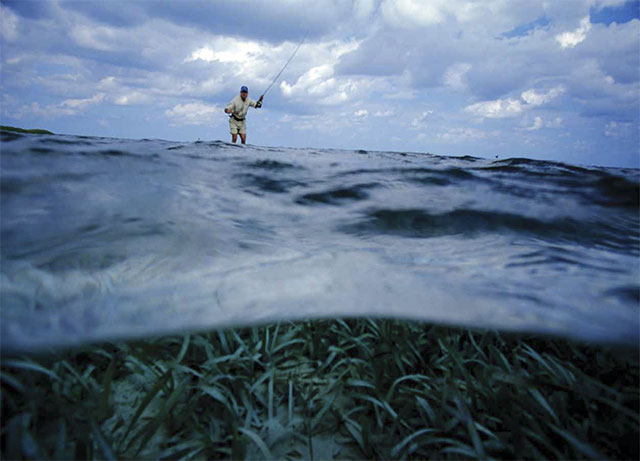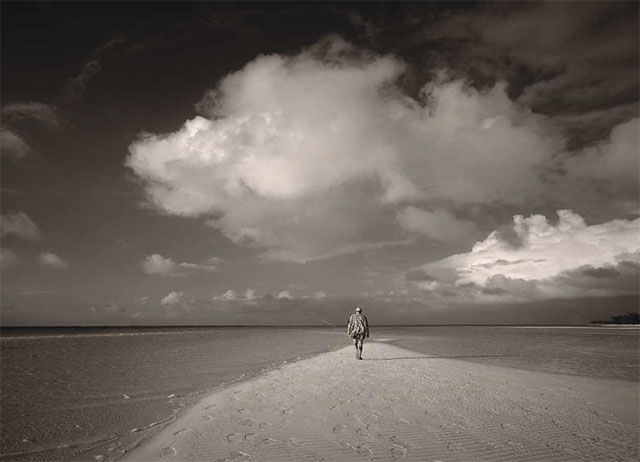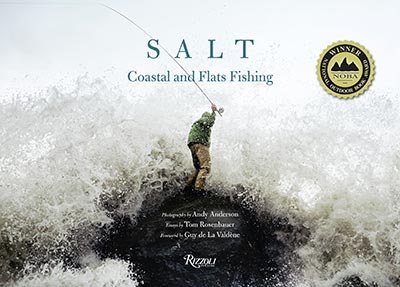“Wading”

When fly fishing in the ocean made a comeback in New England, most of us were wading anglers. I say comeback because despite what fly fishers in the 1970s and 1980s thought, there had been many fly fishers before them in New England waters, back as far as colonial times. But modern tackle, with strong graphite rods and reels with smooth disc drags, made it practical to chase not only schoolie stripers and snapper blues, but also striped bass as big as the ocean could hand out and small tunas like little tunny and bonito that were too strong for early wood rods and single-action reels. Anyway, most of us did not have boats because we were stream fishermen looking for a new challenge.
In the late 1970s, when the striped bass population had crashed and as far as I know bluefish from a boat were the only thing worth chasing in salt water, I met a group of young fly fishers from Pennsylvania who told me they caught bonito and little tunny (or false albacore, as they are known in New England) from shore on Martha’s Vineyard. I had cast into schools of bonito without success while fishing for bluefish, so these speedy little tunas I had seen only as green-barred shapes slashing through schools of sand eels held a special fascination. The anglers invited me to join them and I jumped at the chance.
Their guru—in fact, the godfather to all fly fishers on the Vineyard in those days—was a local named Cooper Gilkes III. At the time, there were only about a half dozen resident fly fishers on the island, including the wonderfully crusty Nelson Bryant, who for many years wrote the “Wood, Field, and Stream” column for The New York Times. But most of the Vineyard anglers looked down on us as effete sissies, which we might have been except for Coop, a deep-voiced, salty character who trapped eels, fished commercially for striped bass, dragged for scallops, and scraped a living from the sea as best as he could. He had not been fly fishing for very long when I first met him, but he was known throughout the island as one of the savviest fishermen around. Kids followed him in pied piper fashion up and down the beach, and his warm and outlandishly generous nature ensured that fly fishing on the island was destined to be accepted in short order.
Over the years, Coop showed me all the ins and outs of getting access to beaches for fishing, in broad daylight and often with a little gentle trespassing at night. When stripers returned with a vengeance in the last two decades of the 20th century, we spent many nights on Lobsterville Beach, wading the gentle surf of Nantucket Sound into the early morning hours, surrounded by bass breaking the surface to eat tiny sand eels—which was at times frustrating because the fish were so small the bass would eat a dozen of them in one gulp and it was only a matter of luck if your fly happened to be in one of the unlucky groups of baitfish.
But it was at the Gut, the north end of Chappaquiddick Island where Cape Pogue Bay dumps into Nantucket Sound, that Coop showed me the most exciting wade fishing I have ever seen in salt water. On both tides, water entering or leaving Cape Pogue Bay squeezes into a narrow channel formed where the sandy elbow of Cape Pogue arches back toward Chappaquiddick. The water is crystalline over a pebbled bottom, and if a helicopter dropped you there blindfolded, when you first looked you might think you were on an Atlantic salmon river. Cape Pogue Bay is a baitfish factory, and from July through October both bonito and little tunny, both pelagic species, run the channel chasing bait in both directions. It’s explosive. You wade out and blind cast over the channel in case a school of fish races in unseen, but usually you get some notice as you hear along the shore from a line of fly fishers—“Here they come, here they come, here they come”—and then they explode in front of you, driving a school of baitfish to the surface.

One of my most vivid memories of fly fishing happened at least 30 years ago at the end of the Gut. I was wading into the shallows when a school of large bonito pinned a school of silversides to the beach, and these open-ocean fish charged into water that barely covered their backs, made a few spins through the shallows, and just as quickly disappeared into the channel. They were so close I could see their eyes and tiny teeth as they chopped into the baitfish. I never even had a chance to make a cast.
Tropical wading, barefoot or with flats boots, with only light pants or shorts and a small chest pack, allows a rare freedom we seldom have in these electronically connected times. Wading the flats, stalking bonefish, permit, or redfish, is an acquired taste not recommended for the impatient. A boat gets you to more places, you can see better from the elevated position, and if you don’t find any fish you can crank up the motor and try a flat miles away. One night in Belize over fruity drinks, I expressed my love of wading to my drinking companion, a high-profile lawyer who expected results at whatever he did. “I don’t like to wade, especially to tailing fish,” he said. “You never know if you’re casting over the rest of the school when you’re so low in the water and lots of times you spook the whole school.”
I didn’t bother to disagree with him, because to me that’s the point. You stalk the fish yourself. You spot the tailer yourself. You make the presentation without any commentary other than that little voice in your head. You take your chance; you hold your breath. You have all the control in the world over the fly you choose and the cast you make, but the reaction of the fish is totally beyond your control and absolutely unpredictable.
Wading in salt water can lead you to experiences impossible to realize in your otherwise loud and busy life. Even if you live in the country, try to think of a time when you cannot at least hear traffic, computer fans, plumbing, or air conditioners. There is a wide flat on a remote part of Grand Bahama Island, far enough up inside that you can’t hear the waves washing up on the outside beach. It’s far enough from trees that you never hear any birds. You can’t hear boats, cars, or airplanes. On a calm day at high noon, when the surface of the flat looks mirrors into the horizon, when you stop walking to look for tails or wakes, there is a silence unlike anything I have ever heard—or not heard. I imagine there are soundproof rooms that may approach this silence, but it’s the closest I have ever been to complete deafness and the total absence of sound except the blood rushing in your ears is disorienting. You feel like you’ve been immersed in a monster bowl of clear Jell-O.
Of all the flats I’ve had the pleasure of wading, I think my favorite ones are the sand flats north of Monomoy Island, just off the “elbow” of Cape Cod. Despite being just over an hour from Boston, the flats are as pristine a spot as you’ll see on the Atlantic coast of North America. The flats are made of hard, white sand, so benign that I’ve waded them in bare feet for decades and never even stubbed my toe. There are no rocks, and no shells on the bottom, and the crabs that scuttle along the sandbars are not big enough to pinch. The only discomfort I’ve ever had there was when I waded through a platoon of small, purple jellyfish, and even those stings went away in 45 minutes.

You can find flats this white and water this transparent in the tropics, but the water that washes over the Monomoy flats does not feel like overheated bath water—it’s cool and refreshing, 62 degrees coming off the ocean, then it’s warmed as the tide pushes over the shallow sandbars so that it’s the perfect temperature in midsummer. Striped bass from two-pound “schoolies” to lone wolfs over 30 pounds cruise these shallows in thigh-deep water, and on a bright day you may be lucky enough to see thousands of stripers in a single outing. These fish are not easy; some days they are as snotty as permit, but if you’re lucky you may get there on a day when they’re cruising the bars acting like junkyard dogs, chasing and nipping anything that looks remotely edible. Sight casting to these fish with crab flies is as exciting as it is elegant.
Some anglers use flats boats for these fish, poling for them like bonefish, and I’ll admit you’ll see more fish and get better shots from a flats boat, but I would rather slink along the edges of the bars in shorts and a T-shirt, working at my own pace, lingering on one flat for an hour and then sliding over to a different flat across a channel, following the tide to the shallowest bar on the flat where I can linger until the tide drops.
Last summer, I was fishing offshore with my friend Captain Tony Biski and his client for the day. We caught some nice stripers in the offshore rips, but Tony’s client, Bill, loved to fish the flats so we left fish to find fish. As we approached the flats in Tony’s shallow draft Jones Brothers we could see scores of big stripers, right up against the beach, so Tony threw the anchor and the three of us wandered off in separate directions. Bill caught several nice bass on crab flies, but at about noon, his dinner from the night before decided to rebel and he asked Tony to take him in, a short seven-mile run to Saquatucket Harbor. Tony could see the despondency in my stride as I waded back to the boat. “You wanna stay out?” he called to me. “You can wade all the way to the end of that point when the tide comes in, just don’t head east because those channels get too deep on the incoming. Just keep working south. I have to run some errands. I’ll come back to get you later.”
When I could no longer distinguish his boat on the horizon, just a tiny spreading wake headed to the mainland, I realized he didn’t say when “later” would be. I was seven miles from the mainland and a couple miles from South Monomoy, an uninhabited bird sanctuary. And between me and the island was a deep channel. I had no cell phone. I hadn’t even grabbed a bottle of water. A couple weeks ago, a great white had been spotted marauding the abundant seals in the shallows just a few miles away. All I had was a rod and reel, a box of flies, and two spools of tippet material—and the whole afternoon to wade that flat.
I was in heaven.
Excerpted with permission from Salt, by Andy Anderson and Tom Rosenbauer (Rizzoli, 2014). All rights reserved.












